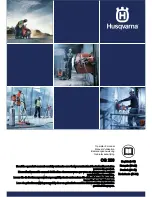
6
3. Fit the threaded outer flange (B) Fig.
4, making sure it is facing in the correct
direction for the type of disc fitted.
For grinding discs Fig. 5, the outer
flange (B) is fitted with the raised
portion facing towards the disc. For
cutting discs, the flange (B) is fitted
with the raised portion facing away
from the disc.
4. Press in the spindle lock button (3)
and rotate the spindle until it locks.
Keeping the spindle lock button
pressed in, tighten the outer flange
with the spanner wrench provided as
shown in Fig. 6.
5. When using a depressed-center
disc, (4) hold the tool so that an
angle of approximately 30° exists
between the disc and the work (see
Fig.10).
WARNING:
Check rated speed
on depressed-center wheel. Never
use a disc with rated speed lower
than the speed on the nameplate of
the tool.
FOR EDGE GRINDING
Edge grinding can be performed only with
Type 27 and hubbed wheels that are
specified for this purpose. Protect yourself
during edge grinding by directing the
open side of the guard toward a surface.
FITTING WIRE CUP BRUSHES
The wire cup brush screws directly on the
spindle of the machine without the use of
flanges. When using wire brushes, thread
firmly on spindle by hand.
CAUTION:
Wear work gloves when
handling wire brushes which can become
sharp.
SANDING
REMOVING THE GUARD (SANDING ONLY)
TURN OFF AND UNPLUG THE TOOL.
NOTE: To prevent loss of control, do
not set tool down until accessory has
completely stopped turning.
This tool is fitted with a guard. For
sanding only, you can remove the guard
as follows:
1. Remove the outer flange, disc and
inner flange if they have been attached.
2. Use a screwdriver to remove the
screws (11).
3. Remove the flange (7), guard (6)
and spring washer (8). Store these
parts carefully.
6
Inner Flange
Outer Flange
Spindle
4
A
B
5
Cutting
Grinding
Grinding Wheel
Disc
11
11
7
8
6
7
FR
ON
T
3
1006292-00 11651 grinderREV 4/16/07 10:53 AM Page 6






































